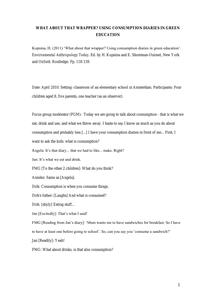This article discusses the rationale for using language diaries as a method to evaluate language use and language choice in multilingual contexts, as well as the benefits and limitations of this approach vis-à-vis other research methods. This is illustrated using examples from two contexts: Flemish Sign Language/Dutch bilinguals in Flanders and Gaelic/English bilinguals in the Western Isles of Scotland. In both cases, the language diaries were part of a larger mixed-method study which aimed to evaluate language use and language choice in contexts in which the majority language is in almost all instances the unmarked choice. Language diaries provide a new perspective on individual language practices as they allow for an evaluation of contextualised examples of language use and give insight into the factors that drive language and modality choice, and language ideologies. Language diaries give participants ownership over the information shared with the researcher and provide access to a number of different domains. Despite being based on self-reported practices, their situated nature demonstrates how language use can change through personal circumstances. This in turn contributes to a greater understanding of the use of Flemish Sign Language and Gaelic in the wider sociolinguistic contexts in which these languages exist.
LINK
Environmental or ‘green' education is an important driving force behind the ‘greening' of society as it plays a critical role in raising environmental awareness and preparing students for green jobs. None of the existing environmental attitudes and behavior measures is focused on the evaluation of green education, especially in relation to consumption. To date, no longitudinal studies of children and students' attitudes towards consumption influenced by education exist. Also, little has been done to explore the socio-cultural context in which attitudes toward consumption are being formed and to explain the cross-cultural differences in environmental attitudes. This pilot study is designed to take the first step towards developing methods complementing existing quantitative measurements with qualitative strategies, such as consumption diaries, focus groups, and concept mapping. While this research is just a first attempt to tackle children's knowledge and attitudes consumption, preliminary results of the research on which this chapter is based and enthusiasm of the research participants encourage the author to stress the importance of consumption studies as part of green education for educational program developers. As a chapter of this volume, the author hopes that this study will add to the anthropological depository of research on the cultural variants in the perception of the environment in children. This chapter draws upon the consumption diaries collected from the upper-elementary school children in Amsterdam, The Netherlands, between September 2009 and May 2010. Consumption diaries are chronological documents recording purchase, use, and waste of materials, which can be used both as analytical tools and the means to stimulate environmental awareness. The four main methodological steps involved in this research were as follows. Children were asked to complete the consumption diary, paying specific attention to use and waste materials. Consequently, focus group meetings were held with parents and their children to discuss the diaries. Finally, interviews with the children were conducted in order to generate statements that supplement those generated by focus groups for carrying out the concept mapping analysis. The concept mapping analysis was then conducted to organize the order and analyze the ideas expressed in the focus group and interview sessions. This is an Accepted Manuscript of a book chapter published by Routledge/CRC Press in "Environmental Anthropology Today" on 8/5/11 available online: https://doi.org/10.4324/9780203806906 LinkedIn: https://www.linkedin.com/in/helenkopnina/
MULTIFILE

This presentation explores various transformations that inform Deaf Studies research, ranging from transformations in deaf networks to larger sign language networks and transformations in applied linguistics, society, and language ideologies, and the related potential impact on sign language policy and revitalisation. After discussing some new research lenses in Deaf Studies, such as visual methods, the presentation suggests some ways forward for Deaf Studies in terms of research priorities and rights discourses.
LINK